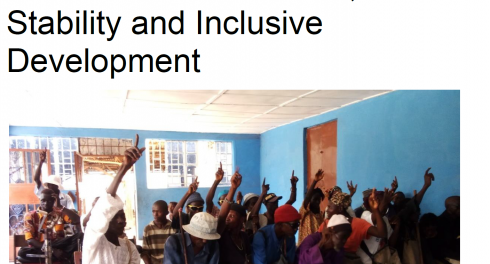Evidence of within-government and citizen-government accountability pathways
 Imagine that you have a million dollars to spend on any kind of information to improve accountability of the government in “Lovely Country”, with the only condition that you cannot spend it on elections. Would you implement scorecards or public dashboards displaying government performance grades, in hopes that citizens will pressure the government to provide improved services? Or maybe you should support a public aid campaign to help the government collect more taxes to fund better public health or education? Or how about giving government officials information on performance of service providers to see if this increases sanctioning of providers that perform poorly? Options are many, and it’s challenging to know which intervention is a good bet in a particular context.
Imagine that you have a million dollars to spend on any kind of information to improve accountability of the government in “Lovely Country”, with the only condition that you cannot spend it on elections. Would you implement scorecards or public dashboards displaying government performance grades, in hopes that citizens will pressure the government to provide improved services? Or maybe you should support a public aid campaign to help the government collect more taxes to fund better public health or education? Or how about giving government officials information on performance of service providers to see if this increases sanctioning of providers that perform poorly? Options are many, and it’s challenging to know which intervention is a good bet in a particular context.
Globally the amount of resources poured into transparency for accountability efforts every year is in the millions, so there is good reason to use evidence to guide these decisions. This was the motivation for the Learning from Evidence Series undertaken by the Transparency and Accountability Initiative (TAI) and MIT GOV/LAB. We examined a number of ways that information can lead to accountability, and emerged with a series of products that help to guide the use of evidence to achieve this. The very first one was a mapping of the main kinds of accountability relationships we could consider; this is the Pathways to Change map.
Based on the map, we conducted a series of literature searches (for the period 2007-2016) and created a suite of products to help guide practitioners and funders in making best use of available evidence. These Learning from Evidence outputs address a range of questions about information for accountability:
- Interested in whether information is effective in getting citizens to hold government officials accountable? Check out the Information and Accountability Evidence Syntheses focused on non-electoral pathways. In this review, we focus on non-elected officials and find that two-thirds of the evidence comes from only three countries: India, Indonesia and Uganda. We found evidence to support claims that in certain contexts and for certain relationships information can be effective, but we don’t want to make “global” statements about effectiveness. Instead, we invite you to consider how the evidence from these specific contexts applies to the particular context in which you are working. We offer guidance on how to do this in our Solutions in Context.
- Is information useful to get government officials to hold other officials accountable? See again the Information and Accountability Evidence Syntheses, which also covers literature on this topic. Here we discovered that the evidence came from only six countries (Brazil, China, India, Pakistan, Tanzania, and Uganda). Moreover, we found only one study on horizontal accountability within government (e.g. courts or judges). This is surprising, given the perceived importance of horizontal accountability institutions in diverse contexts in the global South.
- If you are interested in evidence regarding international norms and standards, check out the memo Effect of International Standards on Accountability Behaviors. The papers we found for this review primarily focused on governance outcomes – e.g. the uptake of the norms and standards in the national legislature. Our main takeaway here is that we know practically nothing about whether international standards and norms (e.g. on accountability of extractive industries) have an effect on accountability behavior of citizens or government actors in a given country. We could not find any studies addressing this question with a clear hypothesis and sufficient methodological rigour to make any conclusions.
- If you are interested in the link between accountability and taxation, have a read through Taxation and Accountability in Developing Countries: Does Taxation Motivate Citizens to Hold Government Accountable? Spoiler alert: The evidence is too thin to make conclusions on whether taxation motivates citizens to hold government accountable for performance. It’s also uncertain whether taxation leads to better governance and more democracy – or whether countries with better governance and more democracy are better able to collect taxes from their citizens.
The above insights point to clear gaps in our collective knowledge, which researchers should help to fill. But what are practitioners and funders to do with these findings, now, before we have more evidence? Our recommendation is that available evidence is most valuable in designing new interventions if it is used to unpack assumptions and specify theories in two ways. First, define which government actors are to be held accountable and by whom, and look for evidence of initiatives that addressed a similar relationship. And, second, prioritize the evidence from a context that is similar to your context. Check out our memo on Solutions in Context for more on this approach.
Going back to Lovely Country and the million dollars you have to spend, there is no way to predict with certainty which intervention path will be most effective. But we hope that our reviews have given you more tools you can use to make more thoughtful, better-informed bets.


